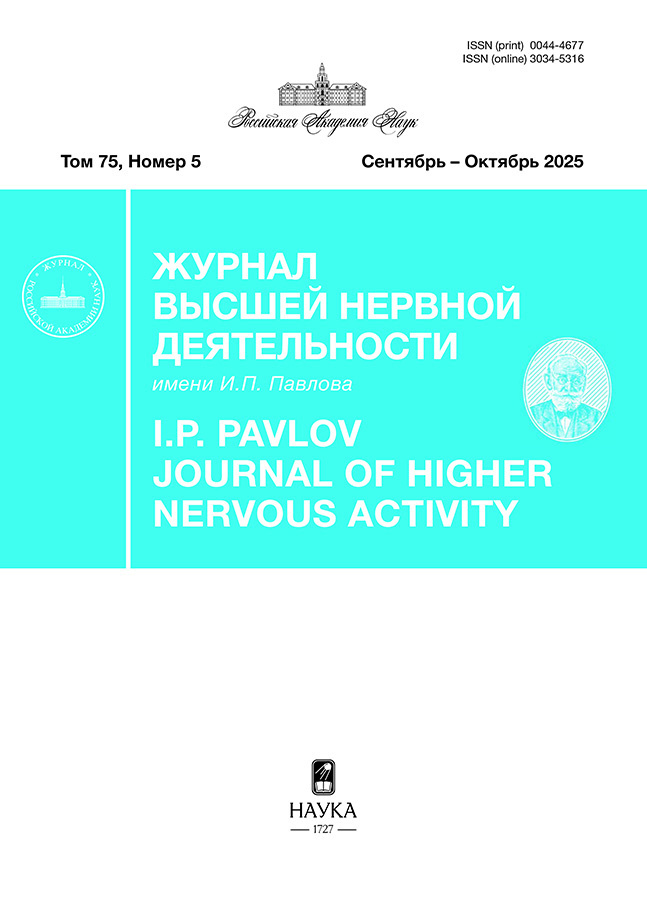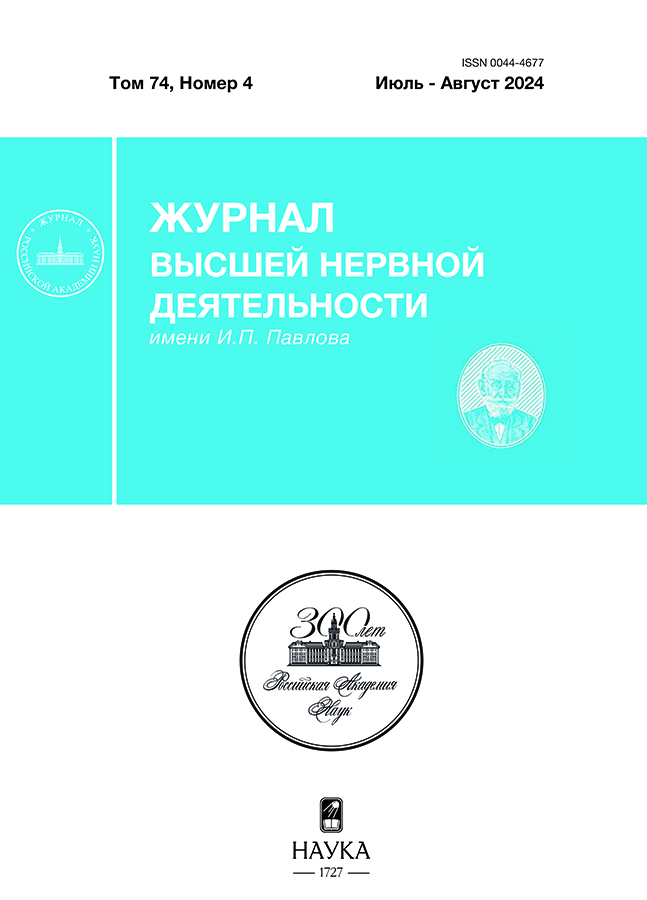Effect of STIN2VNTR polymorphism of the serotonin transporter gene on background EEG in aged subjects depends on the intellectual environment of professional activity
- Authors: Privodnova E.Y.1,2, Volf N.V.1,2
-
Affiliations:
- Scientific Research Institute of Neurosciences and Medicine
- Novosibirsk State University
- Issue: Vol 74, No 4 (2024)
- Pages: 437-449
- Section: ФИЗИОЛОГИЯ ВЫСШЕЙ НЕРВНОЙ (КОГНИТИВНОЙ) ДЕЯТЕЛЬНОСТИ ЧЕЛОВЕКА
- URL: https://cardiosomatics.orscience.ru/0044-4677/article/view/652080
- DOI: https://doi.org/10.31857/S0044467724040057
- ID: 652080
Cite item
Abstract
Previously, we found that associations between the STin2VNTR polymorphism of the serotonin transporter gene and cognitive characteristics during aging depend on the intellectual environment of professional activity. In this regard, the present study was aimed to investigate the age-related characteristics of the electrical activity of the brain depending on this polymorphism and long-term intellectual training. We examined EEG power indicators in subjects of the younger (YG, 18–35 years, N = 261) and older (OG, 55–80 years, N = 142) age groups. According to the intellectual richness of the professional activity environment, the subjects were divided into scientists (SA) and those engaged in non-scientific activities (NSA). All subjects were genotyped for the STin2VNTR polymorphism of the serotonin transporter gene. It was found that the power of delta-beta1 rhythms in older carriers of the 10/10 and 12/12 genotypes was opposite in SA and NSA groups (in the SA group 10/10 > 12/12, in the NSA 12/12 > 10/10) while similar effects in young subjects were absent. In the absence of cognitive training, genetic differences were determined by an age-related decrease in the power of delta-alpha3 rhythms in carriers of the 10/10 genotype with no age-related differences in carriers of the 12/12 genotype, suggesting the resistance of the 12/12 genotype to age-related changes. In contrast, under cognitive training conditions, there were no age differences in the 10/10 genotype, and a decrease in power was observed in the 12/12 genotype, suggesting an effect of cognitive training on both homozygous genotypes. The decrease in power observed for the 10/10 NSA and 12/12 SA genotypes appears to have different physiological significance, since it was accompanied by changes in attentional efficiency only in the NSA group. The work shows for the first time that the background EEG features associated with the STin2VNTR polymorphism of the serotonin transporter gene in elderly people are under the modulating influence of long-term cognitive training, determined by the specificity of professional activity.
Full Text
About the authors
E. Yu. Privodnova
Scientific Research Institute of Neurosciences and Medicine; Novosibirsk State University
Author for correspondence.
Email: privodnovaeu@neuronm.ru
Russian Federation, Novosibirsk; Novosibirsk
N. V. Volf
Scientific Research Institute of Neurosciences and Medicine; Novosibirsk State University
Email: privodnovaeu@neuronm.ru
Russian Federation, Novosibirsk; Novosibirsk
References
- Вольф Н.В., Приводнова Е.Ю. Ассоциации между полиморфизмом STin2VNTR гена транспортера серотонина и характеристиками внимания при старении зависят от интеллектуальной среды профессиональной деятельности. Журн. высш. нервн. деят. им. И.П. Павлова. 2022. 72 (1): 77-86.
- Приводнова Е.Ю., Вольф Н.В. Ассоциации между полиморфизмом STin2VNTR гена транспортера серотонина и фоновой ЭЭГ у молодых и пожилых испытуемых. Физиология человека. 2020. 46 (1): 87–93.
- Шмуклер Ю.Б., Алешина Н.М., Мальченко Л.А., Никишин Д.А. Серотониновая система в оогенезе млекопитающих. Журн. высш. нервн. деят. им. И.П. Павлова. 2021. 71 (3): 306–320.
- Ahmadzadeh M., Cosco T.D., Best J.R., Christie G.J., DiPaola S. Predictors of the rate of cognitive decline in older adults using machine learning. PloS one. 2023. 18 (3): e0280029.
- Alvarez B.D., Morales C.A., Amodeo D.A. Impact of specific serotonin receptor modulation on behavioral flexibility. Pharmacol. Biochem. Behav. 2021. 209: 173243.
- Aoki Y., Hata M., Iwase M., Ishii R., Pascual-Marqui R.D., Yanagisawa T., Kishima H., Ikeda M. Cortical electrical activity changes in healthy aging using EEG-eLORETA analysis. Neuroimage: Reports. 2022. 2 (4): 100143.
- Babiloni C., Binetti G., Cassarino A., Dal Forno G., Del Percio C., Ferreri F., Ferri R., Frisoni G., Galderisi S., Hirata K., Lanuzza B., Miniussi C., Mucci A., Nobili F., Rodriguez G., Luca Romani G., Rossini P.M. Sources of cortical rhythms in adults during physiological aging: a multicentric EEG study. Hum. Brain Mapp. 2006. 27 (2): 162–172.
- Babiloni C., Frisoni G.B., Pievani M., Vecchio F., Lizio R., Buttiglione M., Geroldi C., Fracassi C., Eusebi F., Ferri R., Rossini P.M. Hippocampal volume and cortical sources of EEG alpha rhythms in mild cognitive impairment and Alzheimer disease. Neuroimage. 2009. 44 (1): 123–135.
- Barry R.J., De Blasio F.M. EEG differences between eyes-closed and eyes-open resting remain in healthy ageing. Biol. Psychol. 2017. 129: 293–304.
- Caplan J.B., Bottomley M., Kang P., Dixon R.A. Distinguishing rhythmic from non-rhythmic brain activity during rest in healthy neurocognitive aging. Neuroimage. 2015. 112: 341–352.
- Cools R., Roberts A.C., Robbins T.W. Serotoninergic regulation of emotional and behavioural control processes. Trends Cogn Sci. 2008. 12 (1): 31–40.
- Engedal K., Barca M.L., Hogh P., Bo Andersen B., Winther Dombernowsky N., Naik M. et al. The power of EEG to Predict Conversion from Mild Cognitive Impairment and Subjective Cognitive Decline to Dementia. Dement Geriatr. Cogn. Disord. 2020. 49(1): 38–47.
- Fan J., McCandliss B.D., Sommer T., Raz A., Posner M.I. Testing the efficiency and independence of attentional networks. J. Cogn. Neurosci. 2002. 14:340–347.
- Fan J.C., Cheung R.T., Chu L.W., Fung P.C. W., Chang C.Q., Sik H.H., et al. Age-related changes of EEG and its source in resting state. Proceedings of the 2014 19th International Conference on Digital Signal Processing. 2014. 797–800.
- Gaál Z.A., Boha R., Stam C.J., Molnár M. Age-dependent features of EEG-reactivity--spectral, complexity, and network characteristics. Neurosci. Lett. 2010. 479 (1): 79–84.
- Gaspar P., Cases O., Maroteaux L. The developmental role of serotonin: news from mouse molecular genetics. Nat. Rev. Neurosci. 2003. 4 (12): 1002–1012.
- Gelernter J., Cubells J.F., Kidd J.R., Pakstis A.J., Kidd K.K. Population studies of polymorphisms of the serotonin transporter protein gene. Am. J. Med. Genet. 1999. 88 (1): 61–66.
- Gilbert D.G., Dibb W.D., Plath L.C., Hiyane S.G. Effects of nicotine and caffeine, separately and in combination, on EEG topography, mood, heart rate, cortisol, and vigilance. Psychophysiology. 2000. 37 (5): 583–595.
- Gómez C.M., Vaquero E., López-Mendoza D., González-Rosa J., Vázquez-Marrufo M. Reduction of EEG power during expectancy periods in humans. Acta Neurobiol. Exp. 2004. 64(2): 143–151.
- Hamilton C.A., Schumacher J., Matthews F., Taylor J.P., Allan L., Barnett N. et al. Slowing on quantitative EEG is associated with transition to dementia in mild cognitive impairment. Int. Psychogeriatr. 2021. 33 (12): 1321–1325.
- Han S.H., Chul Youn Y. Quantitative electroencephalography changes in patients with mild cognitive impairment after choline alphoscerate administration. J. Clin. Neurosci. 2022. 102: 42–48.
- Hartikainen P., Soininen H., Partanen J., Helkala E.L., Riekkinen P. Aging and spectral analysis of EEG in normal subjects: a link to memory and CSF AChE. Acta. Neurol. Scand. 1992. 86 (2): 148–155.
- Hranilovic D., Stefulj J., Schwab S., Borrmann-Hassenbach M., Albus M., Jernej B., Wildenauer D. Serotonin transporter promoter and intron 2 polymorphisms: relationship between allelic variants and gene expression. Biol. Psychiatry. 2004. 55 (11): 1090–1094.
- Jabès A., Klencklen G., Ruggeri P., Antonietti J.P., Banta Lavenex P., Lavenex P. Age-Related Differences in Resting-State EEG and Allocentric Spatial Working Memory Performance. Front. Aging. Neurosci. 2021. 13: 704362.
- Jaul E., Barron J. Characterizing the Heterogeneity of Aging: A Vision for a Staging System for Aging. Front. Public Health. 2021. 9: 513557.
- Jeong H.T., Youn Y.C., Sung H.H., Kim S.Y. Power spectral changes of quantitative EEG in the subjective cognitive decline: comparison of community normal control groups. Neuropsychiatr. Dis. Treat. 2021. 17: 2783–2790.
- Kivimäki M., Walker K.A., Pentti J., Nyberg S.T., Mars N., Vahtera J. et al. Cognitive stimulation in the workplace, plasma proteins, and risk of dementia: three analyses of population cohort studies. BMJ. 2021. 374: 1804.
- Könönen M., Partanen J.V. Blocking of EEG alpha activity during visual performance in healthy adults. A quantitative study. Electroencephalogr. Clin. Neurophysiol. 1993. 87 (3): 164–166.
- Lindenberger U., Nagel I.E., Chicherio C., Li S.C., Heekeren H. R., Bäckman L. Age-related decline in brain resources modulates genetic effects on cognitive functioning. Front. Neurosci. 2008. 2(2): 234–244.
- MacKenzie A., Quinn J. A serotonin transporter gene intron 2 polymorphic region, correlated with affective disorders, has allele-dependent differential enhancer-like properties in the mouse embryo // Proc. Natl. Acad. Sci. U S A. 1999. 96 (26): 15251–15255.
- Meghdadi A.H., Stevanović Karić M., McConnell M., Rupp G., Richard C., Hamilton J., Salat D., Berka C. Resting state EEG biomarkers of cognitive decline associated with Alzheimer’s disease and mild cognitive impairment. PloS One. 2021. 16 (2): e0244180.
- Nyberg L., Lövdén M., Riklund K., Lindenberger U., Bäckman L. Memory aging and brain maintenance. Trends Cogn. Sci. 2012. 16 (5): 292–305.
- Papenberg G., Lindenberger U., Bäckman L. Aging-related magnification of genetic effects on cognitive and brain integrity. Trends Cogn. Sci. 2015. 19 (9): 506–514.
- Qiu F., Pi Y., Liu K., Zhu H., Li X., Zhang J., Wu Y. Neural efficiency in basketball players is associated with bidirectional reductions in cortical activation and deactivation during multiple-object tracking task performance. Biol. Psychol. 2019. 144: 28–36.
- Rempe M.P., Ott L.R., Picci G., Penhale S.H., Christopher-Hayes N.J., Lew B.J. et al. Spontaneous cortical dynamics from the first years to the golden years. Proc. Natl. Acad. Sci. U.S.A. 2023. 120 (4): e2212776120.
- Romei V., Rihs T., Brodbeck V., Thut G. Resting electroencephalogram alpha-power over posterior sites indexes baseline visual cortex excitability. Neuroreport. 2008. 19(2): 203–208.
- Shusharina N., Yukhnenko D., Botman, S., Sapunov V., Savinov V., Kamyshov G., Sayapin D., Voznyuk I. Modern methods of diagnostics and treatment of neurodegenerative diseases and depression. Diagnostics. 2023. 13 (3): 573.
- Smailovic U., Jelic V. Neurophysiological markers of Alzheimer’s disease: quantitative EEG approach. Neurol. Ther. 2019. 8(Suppl 2): 37–55.
- Stacey J.E., Crook-Rumsey M., Sumich A., Howard C.J., Crawford T., Livne K., Lenzoni S., Badham S. Age differences in resting state EEG and their relation to eye movements and cognitive performance. Neuropsychologia. 2021. 157: 107887.
- Strac D.S., Pivac N., Muck-Seler D. The serotonergic system and cognitive function. Transl. Neurosci. 2016. 7 (1): 35–49.
- Torres-Simon L., Cuesta P., Del Cerro-Leon A., Chino B., Orozco L.H., Marsh E.B., Gil P., Maestu F. The effects of white matter hyperintensities on MEG power spectra in population with mild cognitive impairment. Front. hum. neurosci. 2023. 17: 1068216.
- Tröndle M., Popov T., Pedroni A., Pfeiffer C., Barańczuk-Turska Z., Langer N. Decomposing age effects in EEG alpha power. Cortex. 2023. 161: 116-144.
- Volf N.V., Gluhih A.A. Background cerebral electrical activity in healthy mental aging. Hum. Physiol. 2011. 37: 559–567.
- Vysata O., Kukal J., Prochazka A., Pazdera L., Valis M. Age-related changes in the energy and spectral composition of EEG. Neurophysiology. 2012. 44: 63–67.
- Wiggins J.L., Bedoyan J.K., Peltier S.J., Ashinoff S., Carrasco M., Weng S.J., Welsh R.C., Martin D.M., Monk C.S. The impact of serotonin transporter (5-HTTLPR) genotype on the development of resting-state functional connectivity in children and adolescents: a preliminary report. Neuroimage. 2012. 59 (3): 2760–2770.
- Wijaya A., Setiawan N.A., Ahmad A.H., Zakaria R., Othman Z. Electroencephalography and mild cognitive impairment research: A scoping review and bibliometric analysis (ScoRBA). AIMS neurosci. 2023. 10 (2): 154–171.
- Williamson P.C., Merskey H., Morrison S., Rabheru K., Fox H., Wands K., Wong C., Hachinski V. Quantitative electroencephalographic correlates of cognitive decline in normal elderly subjects. Arch. Neurol. 1990. 47 (11): 1185–1188.
- Xifra-Porxas A., Niso G., Larivière S., Kassinopoulos M., Baillet S., Mitsis G.D., Boudrias M.H. Older adults exhibit a more pronounced modulation of beta oscillations when performing sustained and dynamic handgrips. NeuroImage. 2019. 201: 116037.
Supplementary files













